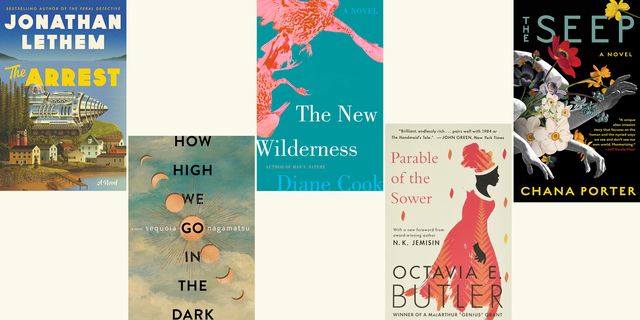1HOW HIGH WE GO IN THE DARK, BY SEQUOIA NAGAMATSU (2022)
 William Morrow
William MorrowIn How High We Go in the Dark, a previously unknown plague is accidentally unleashed from the permafrost, a disaster that will soon leave billions dead or dying. No utopia here, but the episodic stories that make up this novel are full of people (and one very good and entirely unforgettable pig) improving the dangerous world they’ve been saddled with. They care for the dying, search for a cure to the still-ravaging plague (plus Earth’s preexisting problems), and even attempt to settle a distant planet in the hopes of keeping humanity’s best impulses alive somewhere, anywhere, and for as many people as possible. Here, a species-ending extinction event becomes a breeding ground for utopian thought, utopian action, for it’s not individual despair that Nagamatsu’s dystopia breeds but communal hope.
SHOP NOW
2THE ARREST, BY JONATHAN LETHEM (2020)
 Ecco Press
Ecco PressLethem’s latest novel follows a butcher’s assistant/food delivery man named Journeyman, a former screenwriter in a world in which almost all technology has mysteriously failed. Every time I contemplate this particular brand of collapse, I think of novelist Laird Hunt’s comment in an interview: “I sometimes wonder if the epidemic of apocalypse in contemporary fiction isn’t simply a fantasy about shutting all the routers down.” The setting is a “locavore and natural-growing community” established before the Arrest and made into a self-sustaining and egalitarian society after it. This self-governed community even has a postcarceral justice system. Its inhabitants work together to make a better society for themselves, but how will they protect even their most successful social experiments once outside threats come calling?
SHOP NOW
3THE NEW WILDERNESS, BY DIANE COOK (2020)
 Harper Perennial
Harper PerennialIn The New Wilderness, climate change has forced most people into Cities with a capital C: places where pollution-induced diseases are especially rampant. When her daughter, Agnes, sickens, Bea moves the family to the vast emptied Wilderness State as part of a pilot program that allows a small band of people to become nomadic hunter-gatherers. They practice consensus-based decision-making and low-impact living alongside the recovering natural world. Agnes takes to their new life easily, but discontented Bea wants her old world back; even if everything goes perfectly, the recovering Wilderness can never sustain all the people sequestered in the Cities. Things go wrong—this is a novel, after all—but before they do, we experience Agnes not only coming of age but also discovering (or perhaps rediscovering) one of the, hopefully, many sustainable ways we might dwell upon the earth.
SHOP NOW
4THE SEEP, BY CHANA PORTER (2020)
 Soho Press
Soho PressPorter’s debut is an alien invasion–induced utopia. All of humanity’s biggest problems are solved by the intervention of a mysterious entity called the Seep. Left behind is a saved world that the novel’s hero, Trina FastHorse Goldberg-Oneka, struggles to navigate. In The Seep, the focus is less on how we get to a more egalitarian future and more on what it might be like to live within one. If everything were suddenly without cost, how would you cope emotionally with others’ conflicting wants? What would it mean to have the world fixed if your own life were upended in the process? (Also: Won’t some parts of even a very good future be irritating as hell? Yes. Especially for those of us born in the before.)
SHOP NOW
5PARABLE OF THE SOWER, BY OCTAVIA E. BUTLER (1993)
 Grand Central Publishing
Grand Central PublishingWhen Parable of the Sower begins, Butler’s California is a violent place. It’s beset by social breakdown, unregulated corporations, untrustworthy politicians, climate change, and wildfire. Despite these difficulties—or perhaps because of their pressures—Lauren Oya Olamina is a budding utopian. The moves she makes to share her developing Earthseed philosophy provide both hope and instruction. The first steps out of our current crises are arguably the hardest to imagine. Butler gives us one vision of how a person gets herself and others started down that road, beginning not with fearmongering but with education. As Lauren is told: “It’s better to teach people than to scare them.”
SHOP NOW
Advertisement - Continue Reading Below
Advertisement - Continue Reading Below
Advertisement - Continue Reading Below

















